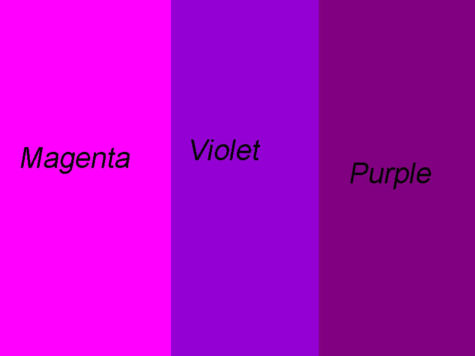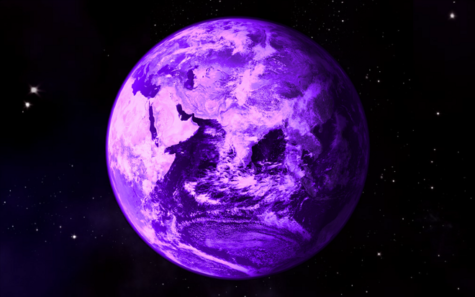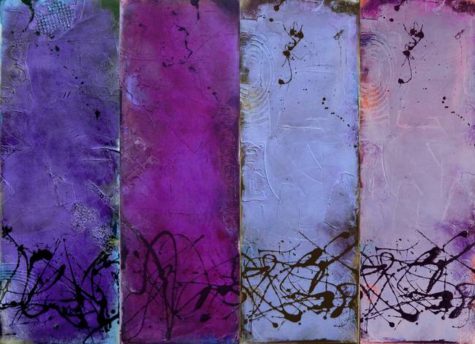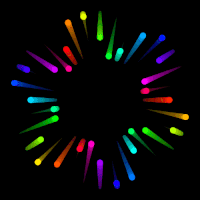Purple
Purple Planet Earth
The earliest life on Earth might have been just as purple as it is green today, a scientist claims.
Ancient microbes might have used a molecule other than chlorophyll to harness the Sun’s rays, one that gave the organisms a violet hue.
Chlorophyll, the main photosynthetic pigment of plants, absorbs mainly blue and red wavelengths from the Sun and reflects green ones, and it is this reflected light that gives plants their leafy color. This fact puzzles some biologists because the sun transmits most of its energy in the green part of the visible spectrum.
“Why would chlorophyll have this dip in the area that has the most energy?” said Shil DasSarma, a microbial geneticist at the University of Maryland.
After all, evolution has tweaked the human eye to be most sensitive to green light (which is why images from night-vision goggles are tinted green). So why is photosynthesis not fine-tuned the same way?
Possible answer
DasSarma thinks it is because chlorophyll appeared after another light-sensitive molecule called retinal was already present on early Earth. Retinal, today found in the plum-colored membrane of a photosynthetic microbe called halobacteria, absorbs green light and reflects back red and violet light, the combination of which appears purple.
Primitive microbes that used retinal to harness the sun’s energy might have dominated early Earth, DasSarma said, thus tinting some of the first biological hotspots on the planet a distinctive purple color.
Being latecomers, microbes that used chlorophyll could not compete directly with those utilizing retinal, but they survived by evolving the ability to absorb the very wavelengths retinal did not use, DasSarma said.
“Chlorophyll was forced to make use of the blue and red light, since all the green light was absorbed by the purple membrane-containing organisms,” said William Sparks, an astronomer at the Space Telescope Science Institute in Maryland, who helped DasSarma develop his idea.
Chlorophyll more efficient
The researchers speculate that chlorophyll- and retinal-based organisms coexisted for a time. “You can imagine a situation where photosynthesis is going on just beneath a layer of purple membrane-containing organisms,” DasSarma told LiveScience.
But after a while, the researchers say, the balance tipped in favor of chlorophyll because it is more efficient than retinal.
“Chlorophyll may not sample the peak of the solar spectrum, but it makes better use of the light that it does absorb,” Sparks explained.
DasSarma admits his ideas are currently little more than speculation, but says they fit with other things scientists know about retinal and early Earth.
For example, retinal has a simpler structure than chlorophyll, and would have been easier to produce in the low-oxygen environment of early Earth, DasSarma said.
Also, the process for making retinal is very similar to that of a fatty acid, which many scientists think was one of the key-ingredients for the development of cells.
“Fatty acids were likely needed to form the membranes in the earliest cells,” DasSarma said.
Lastly, halobacteria, a microbe alive today that uses retinal, is not a bacterium at all. It belongs to a group of organisms called archaea, whose lineage stretches back to a time before Earth had an oxygen atmosphere.
Taken together, these different lines of evidence suggest retinal formed earlier than chlorophyll, DasSarma said.
The team presented its so-called “purple Earth” hypothesis earlier this year at the annual meeting of the American Astronomical Society, and it is also detailed in the latest issue of the magazine American Scientist. The team also plans to submit the work to a peer-reviewed science journal later this year.
Caution needed
David Des Marais, a geochemist at NASA’s Ames Research Center in California, calls the purple Earth hypothesis “interesting,” but cautions against making too much of one observation.
“I’m a little cautious about looking at who’s using which wavelengths of light and making conclusions about how things were like 3 or 4 billion years ago,” said Des Marais, who was not involved in the research.
Des Marais said an alternative explanation for why chlorophyll doesn’t absorb green light is that doing so might actually harm plants.
“That energy comes screaming in. It’s a two-edged sword,” Des Marais said in a telephone interview. “Yes, you get energy from it, but it’s like people getting 100 percent oxygen and getting poisoned. You can get too much of a good thing.”
Des Marais points to cyanobacteria, a photosynthesizing microbe with an ancient history, which lives just beneath the ocean surface in order to avoid the full brunt of the Sun.
“We see a lot of evidence of adaptation to get light levels down a bit,” Des Marais said. “I don’t know that there’s necessarily an evolutionary downside to not being at the peak of the solar spectrum.”
Implications for astrobiology
If future research validates the purple Earth hypothesis, it would have implications for scientists searching for life on distant worlds, the researchers say.
“We should make sure we don’t lock into ideas that are entirely centered on what we see on Earth,” said DasSarma’s colleague, Neil Reid, also of the STScI.
For example, one biomarker of special interest in astrobiology is the “red edge” produced by plants on Earth. Terrestrial vegetation absorbs most, but not all, of the red light in the visible spectrum. Many scientists have proposed using the small portion of reflected red light as an indicator of life on other planets.
“I think when most people think about remote sensing, they’re focused on chlorophyll-based life,” DasSarma said. “It may be that is the more prominent one, but if you happen to see a planet that is at this early stage of evolution, and you’re looking for chlorophyll, you might miss it because you’re looking at the wrong wavelength.”
Variations of the Color Violet
Who in the rainbow can draw the line where the violet tint ends and the orange tint begins? Distinctly we see the difference of the colors, but where exactly does the one first blendingly enter into the other?
~Herman Melville
Purple: The color purple is specifically associated with royalty and the nobility, creating an impression of luxury, wealth and extravagance. Purple has power. It has a richness and quality to it that demands respect. Purple is ambitious and self-assured, the leader.
Light purple: Represents feminine energy and delicacy, as well as romantic and nostalgic feelings.
Deep purple: Dark purple is related to higher spiritual attainment. A powerful color, it can also indicate arrogance and ruthlessness, and may evoke feelings of gloom, sadness, and frustration.
Bright purple: Suggests riches and royalty.
Mauve: Mauve helps us to make the best choices and decisions; it is concerned for justice to be done and always does the right thing. On the other hand it can indicate a degree of commonness, the social climber aspiring to higher ideals.
Lavender: Lavender is attracted to beautiful things. It has a fragility, sensitivity and vulnerability to it. Lavender is a feminine, graceful, elegant color that has long been associated with refined, wealthy women.
Lilac: Lilac implies immaturity, superficiality and youthfulness. It is extroverted and enthusiastic, inspiring glamour, romance, and vanity.
Amethyst: A mystical color, amethyst opens intuitive channels. It protects the vulnerable and assists the humanitarian. It is the color of the evolved soul.
Plum: An old-fashioned color, plum is honorable and linked to family traditions. It is also prudish and narrow-minded, always preaching at you.
Note: This post was compiled by Shirley Twofeathers for Color Therapy, you may repost and share without karmic repercussions, but only if you give me credit and a link back to this website. Blessed be.
Violet vs Purple

In the traditional color wheel used by painters, violet and purple are both placed between red and blue. Purple occupies the space closer to red, between crimson and violet. Violet is closer to blue, and is usually less intense and bright than purple. While the two colors do look similar, from the point of view of optics there are important differences.
Violet is a spectral, or real color – it occupies its own place at the end of the spectrum of light, and it has its own wavelength (approximately 380-420 nm). It was one of the colors of the spectrum first identified by Isaac Newton in 1672, whereas purple is simply a combination of two colors, red and blue. There is no such thing as the “wavelength of purple light”; it only exists as a combination.



